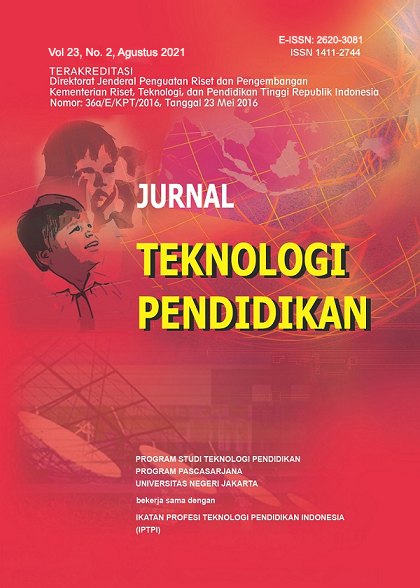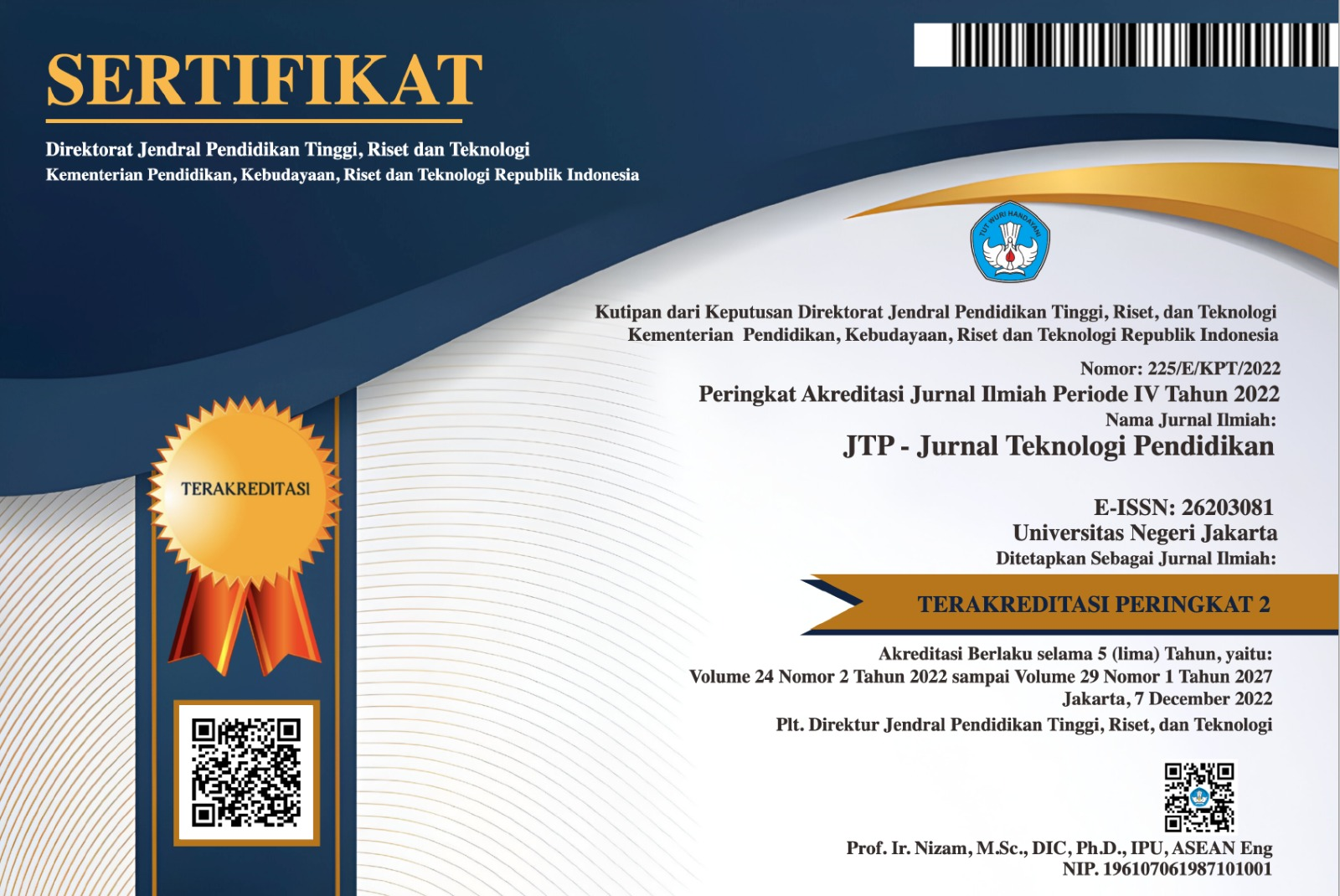Instructional Communication Process in Online Learning (School From Home) during Covid-19 Pandemic
Abstract
Indonesia government taking some actions to break the chain of Covid-19 virus such as Study from Home or online learning that allow teachers and students to study online from their home. The existence of online learning rapidly grows due to the pandemic and changes the way the teachers and the students communicate each other during the class. This research aims to see how the process of instructional communication applied by teacher in doing online learning process in the past few months due to the Covid-19 pandemic. The methodology used in doing the research was qualitative and descriptive approach. This research used Post-Positivism as research paradigm. Data collection techniques were deep interview with the teacher and online classroom observation. Referring to the data analysis model about factors to achieve the instructional communication target such as students’ characteristic, teacher’s characteristic, interaction and methods of delivering the messages, physical facility and surrounding environment, the data analysis technique used was qualitative. This research revealed that instructional communication applied in teaching vocational students is verbal and non-verbal communication. In short, there are two points needed to be highlight for the communication between the teacher and the students during online learning process which are teacher character and the variety used of media. The use of media is divided into two sub points which are main media (Google Classroom and Google Meets) and supported media (Power Point, learning material video and Whatsapp group). Teacher used those media in delivery the lessons to the students to support the online learning process.
References
Abdul Barir hakim. (2016). Efektifitas Penggunaan E-Learning Moodle, Google Classroom dan Edmodo.
Anggraini, M. (2017). Komunikasi Instruksional Guru Dalam Proses Pembelajaran Program Keahlian Rekayasa Perangkat Lunak di SMKN 2 Pekanbaru. JOM FISIP Vol. 4 No. 2. Pekanbaru.
April. I. (2009). Penggunaan Komunikasi Instruksional Oleh Pendidik Di Taman Pendidikan Al Qur’an. Jurnal Ilmiah VISI PTK-PNF - Vol. 4, No.2.
Bell, D., Nicoll, A., Fukuda, K., Horby, P., Monto, A., Hayden, F., ... Van Tam, J. (2006). Nonpharmaceutical interventions for pandemic influenza, national and community measures. Emerging Infectious Diseases. https://doi.org/10.3201/eid1201.051371
Caley, P., Philp, D. J., & McCracken, K. (2008). Quantifying social distancing arising from pandemic influenza. Journal of the Royal Society Interface. https://doi.org/10.1098/rsif.2007.1197
Cecep Kustandi dan Bambang Sutjipto. (2013). Media Pembelajaran Manual dan Digital Edisi Kedua. Bogor: Ghalia Indonesia.
Cheppy, Riyana. (2007). Pedoman Pengembangan Media Video. Jakarta: P3AI UPI.
Firman & Rahman, S.R. (2020). Pembelajaran Online di Tengah Pandemi Covid-19. Indonesian Journal of Educational Science (IJES) Volume 02. Sumatera Barat.
Hamalik, O. (2005). Proses Belajar Mengajar. Jakarta: PT Bumi Aksara.
Japar, dkk. (2019). Media dan Teknologi Pembelajaran PPKn.
Kemendikbud. (2013). Permendikbud No. 109 tentang Penyelenggaraan Pendidikan Jarak Jauh pada Pendidikan Tinggi. Jakarta: Kementrian Pendidikan dan Kebudayaan.
Larasati, Widya dkk. (2013). Efektivitas Pemanfaatan Aplikasi WhatsApp Sebagai Sarana Diskusi Pembelajaran Pada Mahasiswa, http://www/academiaepemang sdu/ 10886930
Maryatun, M. (2015). Pengaruh Penggunaan Media Program Microsoft PowerpointTerhadap Hasil Belajar Strategi Promosi Pemasaran Mahasiswa Semester 2 Program Studi Pendidikan Ekonomi Universitas Muhammadiyah Metro Tahun Ajaran 2014/2015. PROMOSI. Jurnal Pendidikan Ekonomi), 3(1), 1–13.
Mastuti, E. (2016). Pemanfaatan Teknologi Dalam Menyusun Evaluasi Hasil Belajar : Kelebihan dan Kelemahan “Tes Online” Untuk Mengukur Hasil Belajar Mahasiswa . Jurnal Penelitian Psikologi, 07(01), 10–19.
Pawit M. Y. (2010). Komunikasi Intruksional (Teori dan Praktik). Jakarta: Bumi Aksara.
Rasmitadila, Rachmatullah, R., Aliyyah, R.R, Samsudin, A. (2020). The Perceptions of Primary School Teachers of Online Learning during the COVID-19 Pandemic Period: A Case Study in Indonesia. Journal of Ethnic and Cultural Studies.
Riyana, C. (2019). Produksi Bahan Pembelajaran Berbasis Online. Universitas Terbuka.
Rothan, H. A., & Byrareddy, S. N. (2020). The epidemiology and pathogenesis of coronavirus disease (COVID-19) outbreak. Journal of Autoimmunity. https://doi.org/10.1016/j.jaut.2020.102433
Rusman. (2012). Belajar dan Pembelajaran Berbasis Komputer. Bandung: Alfabeta.
Siddiqui, S., & Singh, T. (2016). Social Media its Impact with Positive and Negative Aspects. International Journal of Computer Applications Technology and Research. https://doi.org/10.7753/ijcatr0502.1006
Szpunar, K. K., Moulton, S. T., & Schacter, D. L. (2013). Mind wandering and education: From the classroom to online learning. Frontiers in Psychology. https://doi.org/10.3389/fpsyg.2013. 00495
Sutrisno. (2020). Peningkatan Aktivitas Dan Hasil Belajar Melalui Pembelajaran Online Dengan Google Classroom di Masa Pandemi Covid-19. Bantul
Syah, M. (2011). Psikologi Belajar. Jakarta: Rajawali Press.
Thadi, R. (2019). Proses Komunikasi Instruksional Dalam Pembelajaran Vokasional. JOEAI (Journal of Education and Instruction) Volume 2. DOI: https://doi.org/10.31539/joeai.v2i1.614
West, Richard & Turner, Lynn H. (2009). Pengantar Teori Komunikasi: Analisis dan Aplikasi (Introducing Communication Theory: Analysis and Application). Jakarta: Salemba Humanika.
Copyright (c) 2021 JTP - Jurnal Teknologi Pendidikan

This work is licensed under a Creative Commons Attribution-ShareAlike 4.0 International License.
Jurnal Teknologi Pendidikan is an Open Access Journal. The authors who publish the manuscript in Jurnal Teknologi Pendidikan agree to the following terms.
Attribution-ShareAlike 4.0 International (CC BY-SA 4.0)
-
Attribution — You must give appropriate credit, provide a link to the license, and indicate if changes were made. You may do so in any reasonable manner, but not in any way that suggests the licensor endorses you or your use.
-
ShareAlike — If you remix, transform, or build upon the material, you must distribute your contributions under the same license as the original.
- No additional restrictions — You may not apply legal terms or technological measures that legally restrict others from doing anything the license permits.
Notices:
- You do not have to comply with the license for elements of the material in the public domain or where your use is permitted by an applicable exception or limitation.
- No warranties are given. The license may not give you all of the permissions necessary for your intended use. For example, other rights such as publicity, privacy, or moral rights may limit how you use the material.








